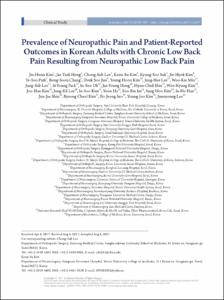KUMEL Repository
1. Journal Papers (연구논문)
1. School of Medicine (의과대학)
Dept. of Neurosurgery (신경외과학)
Prevalence of Neuropathic Pain and Patient-Reported Outcomes in Korean Adults with Chronic Low Back Pain Resulting from Neuropathic Low Back Pain
- Keimyung Author(s)
- Kim, In Soo
- Department
- Dept. of Neurosurgery (신경외과학)
- Journal Title
- Asian Spine Journal
- Issued Date
- 2017
- Volume
- 11
- Issue
- 6
- Keyword
- Chronic low back pain; Neuralgia; Prevalence; Quality of life
- Abstract
- Study Design:
A noninterventional, multicenter, cross-sectional study.
Purpose:
We investigated the prevalence of neuropathic pain (NP) and patient-reported outcomes (PROs) of the quality of life (QoL) and functional disability in Korean adults with chronic low back pain (CLBP).
Overview of Literature:
Among patients with CLBP, 20%-55% had NP.
Methods:
Patients older than 20 years with CLBP lasting for longer than three months, with a visual analog scale (VAS) pain score higher than four, and with pain medications being used for at least four weeks before enrollment were recruited from 27 general hospitals between December 2014 and May 2015. Medical chart reviews were performed to collect demographic/clinical features and diagnosis of NP (douleur neuropathique 4, DN4). The QoL (EuroQoL 5-dimension, EQ-5D; EQ-VAS) and functional disability (Quebec Back Pain Disability Scale, QBPDS) were determined through patient surveys. Multiple linear regression analyses were performed to compare PROs between the NP (DN4≥4) and non-NP (DN4<4) groups.
Results:
A total of 1,200 patients (females: 65.7%; mean age: 63.4±13.0 years) were enrolled. The mean scores of EQ-5D, EQ-VAS, and QBPDS were 0.5±0.3, 55.7±19.4, and 40.4±21.1, respectively. Among all patients, 492 (41.0%; 95% confidence interval, 38.2%-43.8%) suffered from NP. The prevalence of NP was higher in male patients (46.8%; p<0.01), in patients who had pain based on radiological and neurological findings (59.0%; p<0.01), and in patients who had severe pain (49.0%; p<0.01). There were significant mean differences in EQ-5D (NP group vs. non-NP group: 0.4±0.3 vs. 0.5±0.3; p<0.01) and QBPDS (NP group vs. non-NP group: 45.8±21.2 vs. 36.3±20.2; p<0.01) scores. In the multiple linear regression, patients with NP showed lower EQ-5D (β=-0.1; p<0.01) and higher QBPDS (β=7.0; p<0.01) scores than those without NP.
Conclusions:
NP was highly prevalent in Korean patients with CLBP. Patients with CLBP having NP had a lower QoL and more severe dysfunction than those without NP. To enhance the QoL and functional status of patients with CLBP, this study highlights the importance of appropriately diagnosing and treating NP.
- Keimyung Author(s)(Kor)
- 김인수
- Publisher
- School of Medicine (의과대학)
- Citation
- Jin-Hwan Kim et al. (2017). Prevalence of Neuropathic Pain and Patient-Reported Outcomes in Korean Adults with Chronic Low Back Pain Resulting from Neuropathic Low Back Pain. Asian Spine Journal, 11(6), 917–927. doi: 10.4184/asj.2017.11.6.917
- Type
- Article
- ISSN
- 1976-1902
- Appears in Collections:
- 1. School of Medicine (의과대학) > Dept. of Neurosurgery (신경외과학)
- 파일 목록
-
-
Download
 oak-2018-0886.pdf
기타 데이터 / 577.23 kB / Adobe PDF
oak-2018-0886.pdf
기타 데이터 / 577.23 kB / Adobe PDF
-
Items in Repository are protected by copyright, with all rights reserved, unless otherwise indicated.